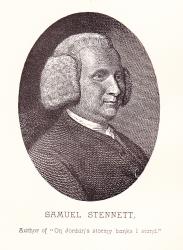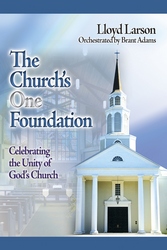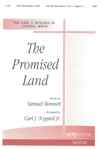- |
User Links
On Jordan's stormy banks I stand

On Jordan's stormy banks I stand
Author: Samuel Stennett (1787)Tune: PROMISED LAND (American)
Closing Songs
Published in 1379 hymnals
Printable scores: PDFPlayable presentation: Lyrics only, lyrics + musicAudio files: MIDI, Recording
Representative Text
1 On Jordan's stormy banks I stand,
and cast a wishful eye
to Canaan's fair and happy land,
where my possessions lie.
Refrain:
I am bound for the promised land,
I am bound for the promised land;
oh, who will come and go with me?
I am bound for the promised land.
2 O'er all those wide extended plains
shines one eternal day;
there God the Son forever reigns,
and scatters night away. [Refrain]
3 No chilling winds or poisonous breath
can reach that healthful shore;
sickness and sorrow, pain and death,
are felt and feared no more. [Refrain]
4 When I shall reach that happy place,
I'll be forever blest,
for I shall see my Father's face,
and in his bosom rest. [Refrain]
United Methodist Hymnal, 1989
Author: Samuel Stennett
 Samuel Stennett was born at Exeter, in 1727. His father was pastor of a Baptist congregation in that city; afterwards of the Baptist Chapel, Little Wild Street, London. In this latter pastorate the son succeeded the father in 1758. He died in 1795. Dr. Stennett was the author of several doctrinal works, and a few hymns.
--Annotations of the Hymnal, Charles Hutchins, M.A. 1872.… Go to person page >
Samuel Stennett was born at Exeter, in 1727. His father was pastor of a Baptist congregation in that city; afterwards of the Baptist Chapel, Little Wild Street, London. In this latter pastorate the son succeeded the father in 1758. He died in 1795. Dr. Stennett was the author of several doctrinal works, and a few hymns.
--Annotations of the Hymnal, Charles Hutchins, M.A. 1872.… Go to person page >Text Information
Related Texts
| First Line: | On Jordan's stormy banks I stand |
| Author: | Samuel Stennett (1787) |
| Meter: | 6.8.6.8 |
| Language: | English |
| Publication Date: | 1792 |
| Copyright: | Public Domain |
| Liturgical Use: | Closing Songs |
English
- A Book of Worship for the Use of the Evangelical Lutheran Church ... of the Church of the Redeemer, Richmond, Virginia #d131
- A Choice Selection of Evangelical Hymns, from various authors: for the use of the English Evangelical Lutheran Church in New York #436
- A Choice Selection of Hymns and Spiritual Songs for the use of the Baptist Church and all lovers of song #401
- A Choice Selection of Hymns. 2nd ed. #d167
- A Choice Selection of Hymns. 6th ed. #d203
- A Choice Selection of Psalms, Hymns and Spiritual Songs for the use of Christians #567
- A Collection of Choral Hymns for the ... Hanson Place Methodist Episcopal Congregation #d143
- A Collection of Evangelical Hymns; made from Different Authors and Collections for the English Lutheran Church in New York #d193
- A Collection of Evergreen Hymns, for All the People. New ed. #d110
- A Collection of Hymns #413 10 shown out of 838
German
Spanish
Notes
Access an additional article on the Canterbury Dictionary of Hymnology:
For Leaders
Text:
The original text of this hymn was in seven stanzas with no refrain. It was written by Samuel Stennett, who was an English minister, and first appeared in John Rippon's A Selection of Hymns in 1787 in London. The theme of this full text is the vision of the believer as he or she approaches death, based on the description of heaven in Revelation 22.
This text made its way to America and was adapted there to a different view. The elimination of three stanzas (original st. 2, 3, and 7) and the addition of a camp-meeting refrain alter the picture. In the American version, this hymn is a song for one still on the journey to a nice place instead of Stennett's picture of one who has glimpsed a breathtaking scene so near that one can almost touch it. The collection that made this text well-known was William Walker's Southern Harmony of 1835, in which at least the first stanza of this hymn appears four times, each with a different refrain and tune. The refrain that is most common in modern hymnals begins “I am bound for the Promised Land.”
Tune:
The tune to which this hymn is most commonly sung is PROMISED LAND, which appeared at number 51 in William Walker's Southern Harmony in 1835; it was attributed to “Miss M. Durham,” who has not yet been identified. It is named after the refrain. The original version of the tune was in three-part harmony with the tune in the middle part in a minor key. Rigdon McIntosh revised the rhythm and transcribed the tune to a major key for publication in A Collection of Hymns and Tunes in 1874. This suited the musical fashion of the time, and it is the version found in modern hymnals.
When/Why/How:
This hymn is suitable for services with an eschatological theme or preaching on Revelation 22. Other hymns that would blend well musically and thematically include “When We All Get to Heaven” and “Shall We Gather at the River?” For blended worship services, a contemporary tune for this text was written by Christopher Miner of Indelible Grace. A SAB choral arrangement that shows the charm of the original minor key version of the tune is “The Promised Land.” A bass instrumental solo that would work well for a postlude is found in “Early American Hymns.”
Tiffany Shomsky, Hymnary.org
Timeline
Arrangements
Media
Small Church Music #3695
- PDF Score (PDF)
The United Methodist Hymnal #724
- MIDI file from Baptist Hymnal 1991 #521
- Audio recording from Baptist Hymnal 1991 #521
- MIDI file from Baptist Hymnal 1991 #521
- Audio recording from Baptist Hymnal 2008 #611
- Audio recording from Celebrating Grace Hymnal #556
- MIDI file from The Cyber Hymnal #5032
- Audio recording from Evangelical Lutheran Worship #437
- MIDI file from Make Christ King: a selection of high class gospel music for use in general worship and special evangelistic meetings #261
- Audio recording from The New Century Hymnal #598
- Audio recording from Small Church Music #3695
- MIDI file from Songs of Gladness for the Sabbath School #77a
- Audio recording from The Southern Harmony, and Musical Companion (New ed. thoroughly rev. and much enl.) #51
- MIDI file from The Southern Harmony, and Musical Companion (New ed. thoroughly rev. and much enl.) #51
- MIDI file from The Southern Harmony, and Musical Companion (New ed. thoroughly rev. and much enl.) #137
- MIDI file from The Southern Harmony, and Musical Companion (New ed. thoroughly rev. and much enl.) #253
- MIDI file from The Southern Harmony, and Musical Companion (New ed. thoroughly rev. and much enl.) #318
- MIDI file from The United Methodist Hymnal #724
- Audio recording from The United Methodist Hymnal #724
- MIDI file from Worship and Rejoice #519


 My Starred Hymns
My Starred Hymns






